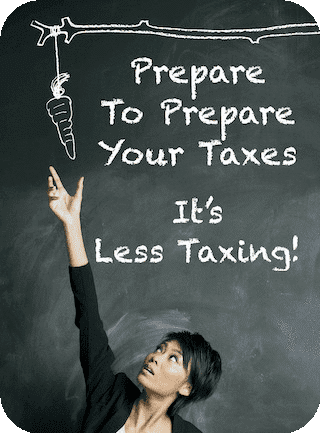Tax Return Step-by-Step Guide
Filing your taxes online is as simple as gathering your tax forms, entering them into your online account, and pressing the submit button. Anyone can file their taxes on their own by following this guide - don't stress over IT: IT is Income Taxes.

This is a high-level step by step guide on how to prepare to prepare and e-file your next federal and/or state income tax return(s). Self-preparing and e-filing your taxes is as simple as following this guide. Use this high level and easy to understand overview of the latest tax changes you can expect.
Learn how to be smart with your taxes.
Tax Tip: If you expect to owe taxes on your next tax return, e-file your return or tax extension on time as the late filing penalties are higher than the late payment penalties. Most taxpayers are not aware of this, so file and pay as little or as much as you can on taxes. If you expect a refund, don't let your refund expire. Use this free IRS tax return and refund calculator tool to find out what your next return may look like.
Recommendation: A well planned out and prepared income tax return might have to take less steps on the IRS Tax Return roadmap. Follow these tips to avoid tax return and refund processing delays:
- Collect all your tax-related paperwork, including W-2 and 1099 income forms, tax deduction forms or statements, and last year's return with your adjusted gross income.
- Use electronic filing or e-filing to send your return online - the eFile Tax App is an IRS-tested and authorized e-file service that guarantees 100% accuracy based on your entries.
- Ensure all your identifying information is correct: enter your legal name(s), birthdate(s), and Social Security Number(s) for you, your spouse, and your dependent(s); select the correct filing status.
- Answer the digital asset question - no need to worry for eFilers as the eFile App will not let you proceed unless you answer this question since it is required by the IRS.
- Report all your taxable income and withholding; remember that employers, brokers, and other financial institutions send a copy of your forms to the IRS, so your information must match what they receive. If you miss a form, the IRS may correct it and send you a notice, but you also may need to file a tax amendment.
- Double check your banking routing number and account number - this cannot be changed once your return is accepted.
- Download a copy of your accepted return and keep it for your records.
Follow our tax return preparation checklist to plan and prepare for your online tax returns on eFile.com. It will not only assist you in gathering all the important tax records and documents you need to prepare and e-file your federal and state tax returns, but also assure a more accurate and faster process.

How to Prepare for Tax Filing
The tax season lasts from January through the October tax deadline. In December leading up to the end of the year, go over any financial records that may apply to your situation. It is important to gather any documents you may need as they become available as well as last year's adjusted gross income or AGI. Retrieve receipts, statements, and other records you may need to write off or include on your income tax return. Once you have all your tax records, sign up and start preparing your return; the eFile Tax App will generate the federal and state forms based on information entered on your account.
In this table, find various tax buzzwords you may come across accompanied by information for that topic and action(s) to take.
Get Your Personal IP-PIN
Beginning in early January, you can obtain your personal
IP-PIN or Identity Protection - Personal Identification Number - for an extra layer of security.
This is not required. An IP-PIN will protect your SSN from being compromised and only you can e-file a tax return with your SSN because you will be asked to enter the IP-PIN during e-filing for validation purposes.
Get your
IP-PIN directly from the IRS . If the IRS assigns an IP PIN to you or you sign up for on one your own, you will need this to e-file and can retrieve it using the link. The IRS assigns a new IP PIN each year and they generally mail a notice with the number; otherwise, get it online using the link.
Don't Rush IT
IT = Income Taxes. Most income and deduction forms will arrive in your mailbox and/or electronically by January 31. Start to prepare early but don't e-file unless you are 100% certain you got
all your forms to avoid
tax amendments.
See the preparation checklist before you e-file and view
tax return forms you can e-file or not.
Tax Payments
Certain types of income require you to make
estimated tax payments throughout the year. If you are self-employed, you may be responsible for these estimated payments.
Pay your estimated taxes to the IRS directly by the four quarterly deadlines. After the tax year, the last quarterly payment is due by January 15 following the year.
Dependents
Should you file yourself or as
someone's dependent on your tax return? Find out who to claim as your dependent and how to claim them.
Tax Estimator
Estimate your tax refund or taxes owed before you start filing or e-filing your tax return. Find other free calculators courtesy of eFile.com and better understand your tax situation.
Use our free
tax refund calculator to enter information and get real results as you work. Know your estimated refund or taxes owed before you file your taxes.
Penalty!
Even if you can't
pay for the taxes you might owe, you should either file a tax return or an extension by
Tax Day. The penalty for not filing is higher than the penalty for not paying.
Pay Taxes
Review eFile.com and
IRS tax payments options and learn how to pay your taxes. You can make payments online directly to the IRS and most states.
Withhold
Assess your
tax withholdings throughout the year and factor in all your income (W-2, 1099, etc.). Keep more of your money during the year if you received a large refund.
Tax Plan
Don't wait until the end of the tax year to
assess your taxes. Plan in July and before the end of the year, December 31.
Tax Return Roadmap
A well planned out and prepared tax return might take less steps of the
IRS tax return roadmap.
Here is an outline of all the potential steps an IRS tax return might have to go through:
IRS tax return roadmap.
State Income Taxes
State returns vary state by state and some can get more complicated than others. On eFile.com, your state return is automatically generated with your return based on your federal information so you generally do not have to fill in any state forms. Review this guide if you need to (or want to) file a state tax return:
State Income Tax Calculators
Calculate and estimate your state income tax return for free! These
state tax calculators can break down your taxes by state to help you better understand what your state return might look like.
File a State Return
State returns can only be e-filed with a federal return as per law. Prepare and e-file your federal and state returns together so you can file them electronically and not have to mail anything.
You can
prepare and e-file your state tax return on eFile.com when filing your federal taxes. The eFile Tax App will generate your state return based on your federal forms and, generally, no extra work is needed.
Start for free and add your state return once you have finished entering all your tax data.
After Your Tax Return Has Been Submitted
Once you have finished your forms and filed your return, the IRS and state will process it. If you e-file via eFile.com, monitor your account and email for important information. Find out what to do after you submit your tax return.
Did it go through?
After you have e-filed your return, monitor your emails, check your eFile.com account, and/or check your tax refund status -
get your return status now.
Show me the money!
Make sure your
tax refund will be directly deposited into your account
or mailed to the address on your tax return.
Tax records
Download your completed tax return from your eFile.com account under My Account and keep it for your records. If you did not file your return on eFile.com (or even if you did), you may obtain a free transcript of your return from the IRS.
Get Ready to File Your Tax Return with eFile.com
If all of this is overwhelming for you, simply create a free account on eFile.com and start the tax interview process by answering simple questions. We make it easy for you so you don't have to worry about too many of the complicated tax law details. You can monitor your preliminary IRS and state tax return as you go through the process. Before you actually eFile your tax return, make sure you check for errors and overall results or contact one of our Taxperts® if you have questions.
TurboTax® is a registered trademark of Intuit, Inc.
H&R Block® is a registered trademark of HRB Innovations, Inc.